Sun-drenched stone, silvery foliage, and azure accents are defining today’s surge of interest in Greek gardens, with online searches leaping 250 % in 2025 as homeowners hunt for drought-tough yet romantic ways to style their yards. Grounded in centuries-old Mediterranean wisdom—think olives, herbs, and pebble mosaics—these spaces marry low-maintenance planting with sensory pleasures such as citrus perfume and gently splashing fountains. The following twenty ideas translate the essence of a Greek garden into practical, bite-size projects you can start this season, whether you nurture a courtyard, balcony, or acres of hillside.
1. Olive Grove Allure

A gentle breeze shimmering through an olive’s silver leaves instantly signals a Greek garden, even if you only have room for two container-grown specimens. Situate the pots where they bask in at least six hours of sun and water sparingly to deepen root resilience—established olives tolerate brief drought and can live for decades. Clip lightly after fruiting to maintain a manageable canopy that still casts dappled shade for evening meals. Fertilize once in spring with a balanced, low-nitrogen feed that supports fruit set without forcing lush, floppy growth. Tuck drought-loving thyme at each pot’s edge; the herb masks bare soil while echoing classic Greek understory planting.
2. Terracotta Amphora Accents
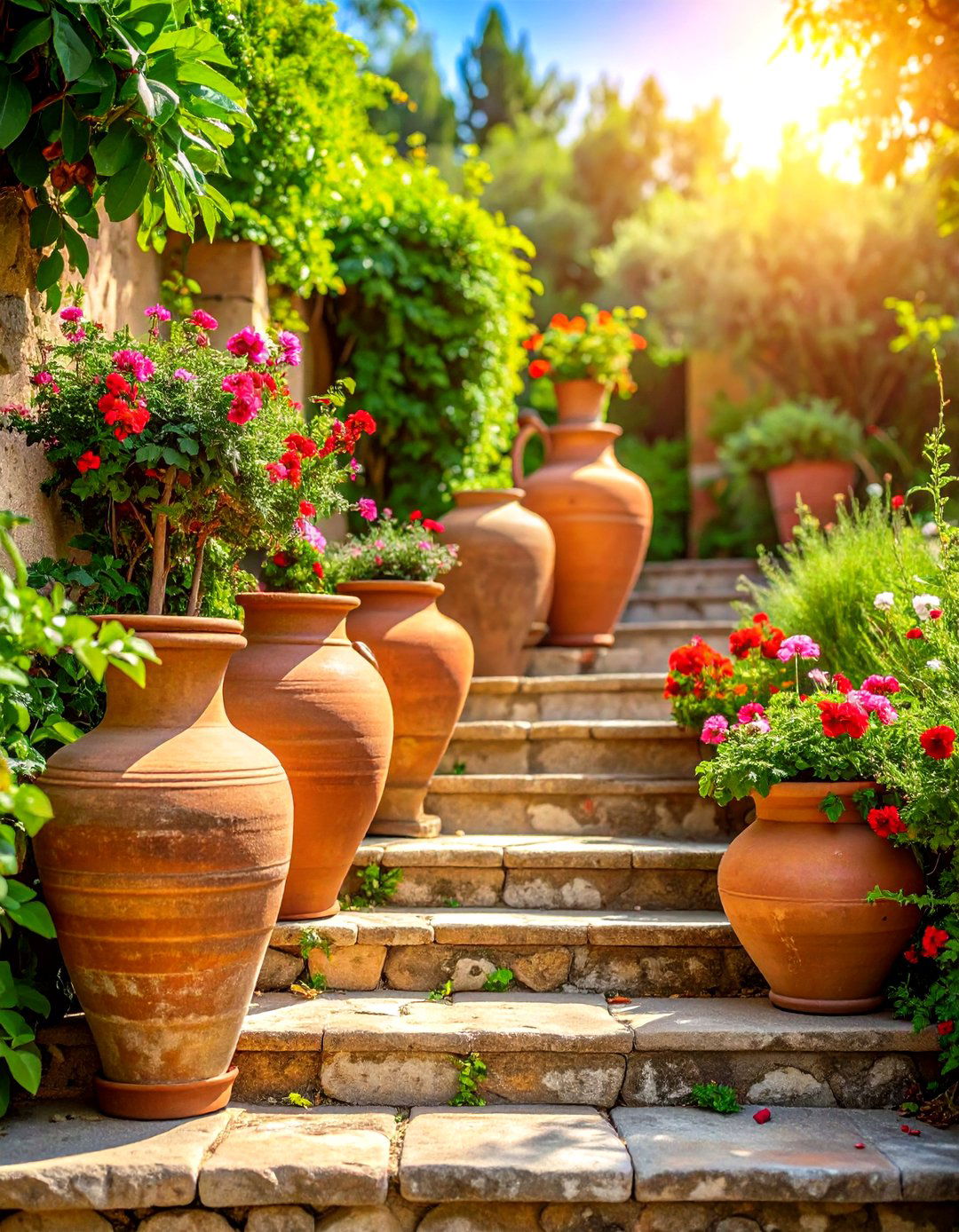
Consider grouping weathered amphora and squat urns beside steps or seating to channel the rustic pottery scattered across island villages. Their burnt-orange clay pops against limestone walls and harmonizes with sage-green foliage. For authenticity, leave salt crusts and minor chips; patina tells a story in Greek gardens. Fill a few vessels with scented geraniums or trailing rosemary so fragrance wafts as you brush past. Drill drainage holes if needed—Mediterranean plants resent “wet feet.” Rotate empty amphora seasonally: in winter they stand sculptural; in summer they overflow with basil or compact lavender.
3. Whitewashed Walls & Blue Trim
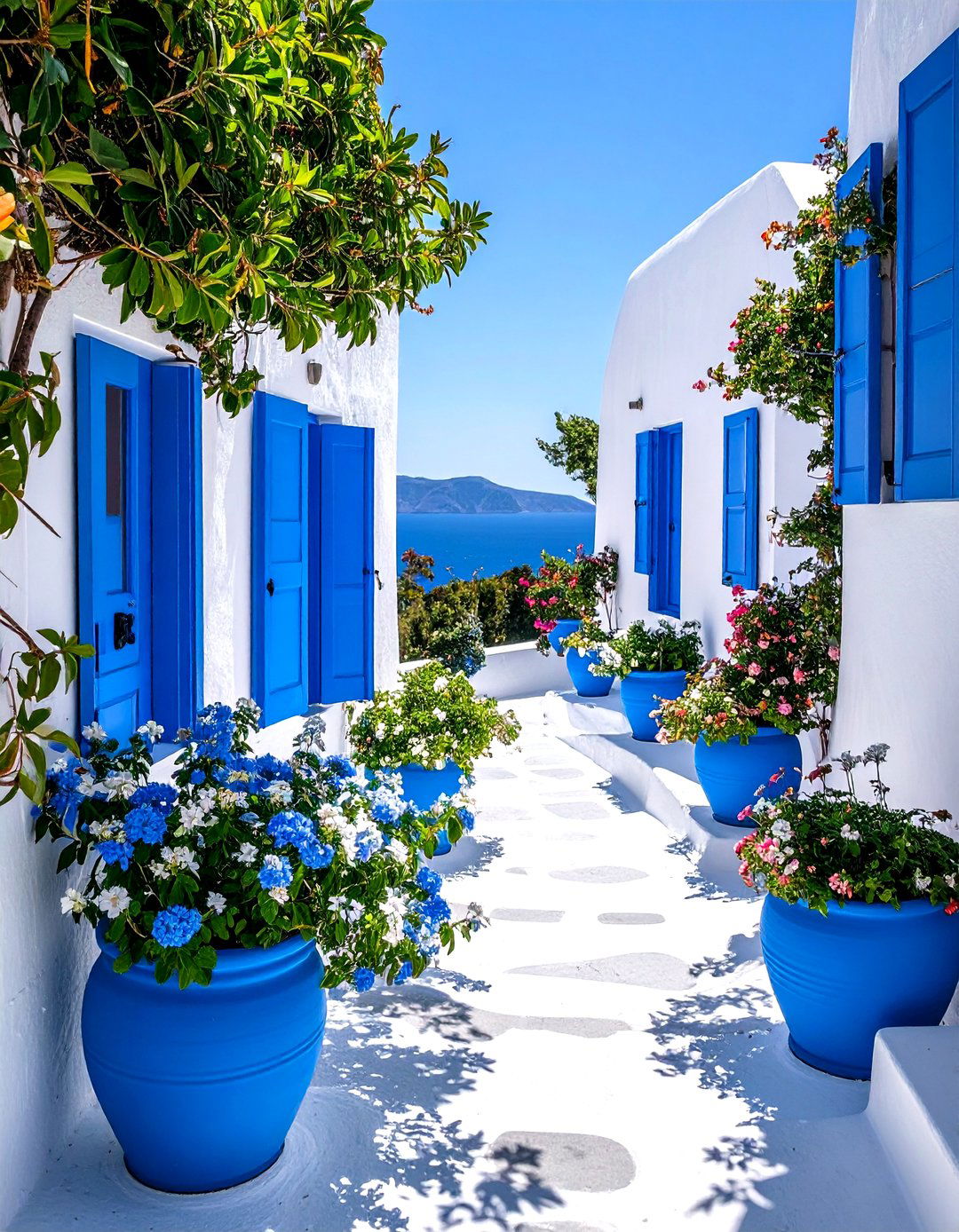
Unlike ornate plaster elsewhere in the Mediterranean, Greek garden architecture relies on limewashed walls that bounce light and disinfect surfaces—a tradition dating to a 1938 public health edict. Fresh coats of matte white set off cobalt shutters or planters, mirroring Cycladic streets. Paint low retaining walls or raised beds to create instant brightness and a backdrop for gray-green foliage. Because limewash is breathable, it protects masonry from trapped moisture, so your hardscape ages gracefully. Finish edges with bold blue pots to anchor the color theme without overdecorating.
4. Pergola Draped in Vines
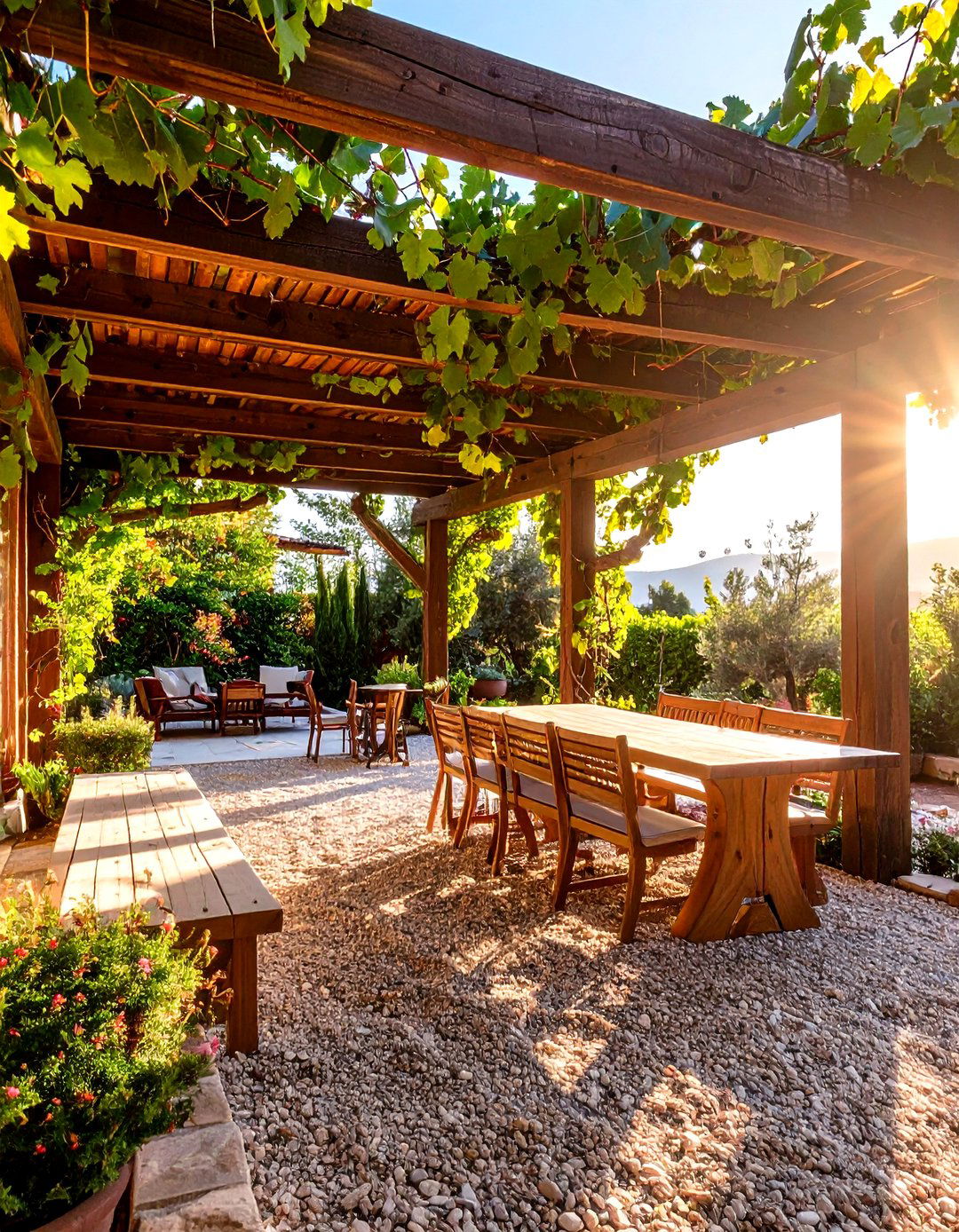
With filtered shade essential for outdoor lunches, a timber pergola cloaked in grapevines echoes Greek tavern courtyards. Train two vines up the corner posts and laterally along wires, pruning each winter to maintain an airy canopy and encourage fruit. Between harvests, dangling clusters lend an edible chandelier that charms guests. If grapes won’t thrive in your climate, substitute hardy jasmine or passionflower—both recommended for Mediterranean pergolas—yet keep the structure robust enough to bear mature stems. Beneath, scatter gravel to absorb heat by day and release warmth after sunset.
5. Pebbled Mosaic Pathways

A footpath paved in black-and-white pebble patterns—waves, spirals, or the Greek key—adds slip-resistant texture while referencing ancient courtyard craft. Lay motifs in a shallow mortar bed, tamping stones so tops sit flush for comfortable walking. Edge the ribbon with low herbs that spill fragrance when crushed under sandals. Seal with a permeable fixer to deter weeds yet allow rain to percolate, preserving Mediterranean drainage principles. Lighting tucked at ground level makes the mosaic sparkle at night.
6. Aromatic Herb Parterre
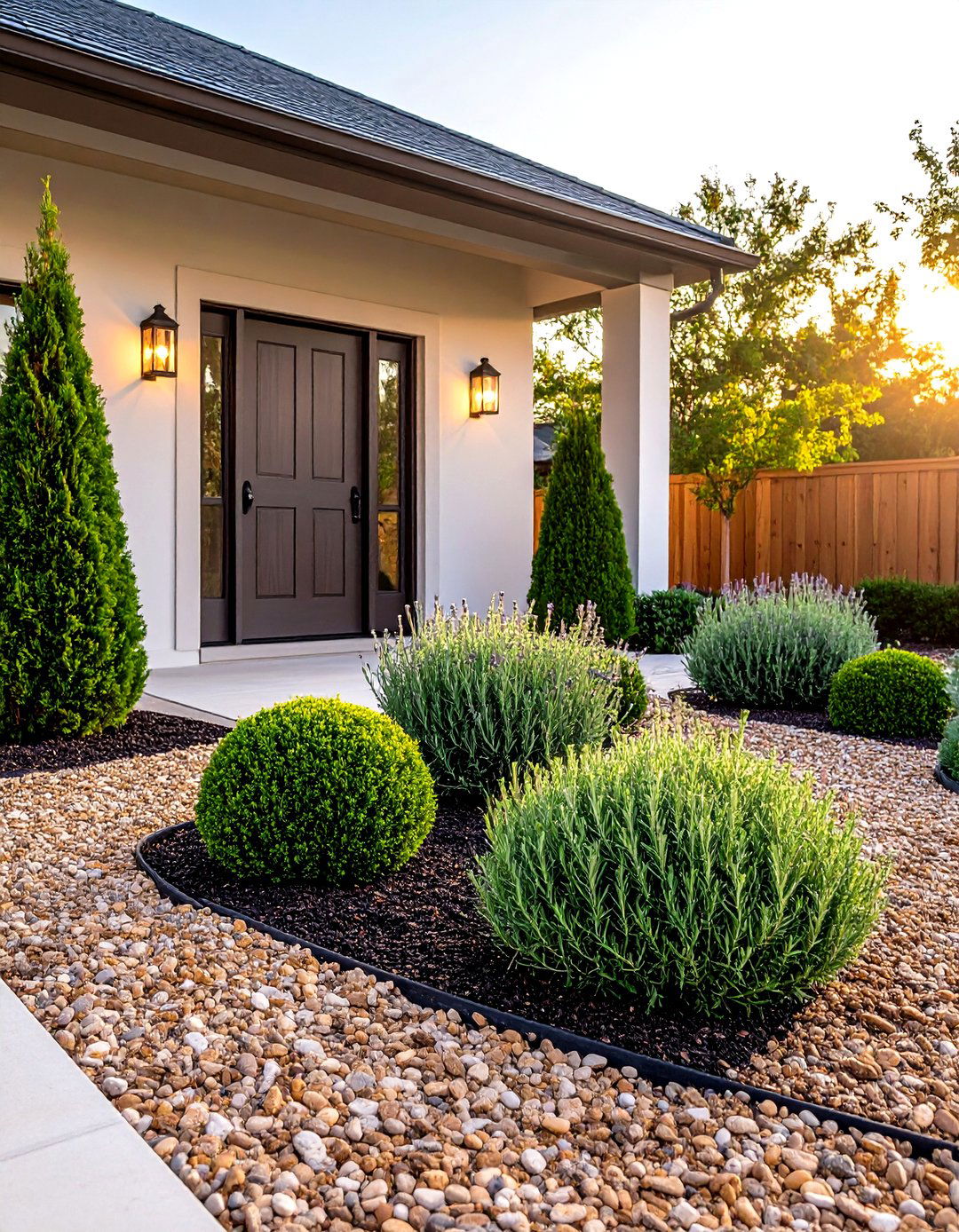
Surprisingly, sculpted parterres aren’t just for French châteaux; Greeks also corral herbs into knot-work beds for convenient harvesting. Box hedging or clipped rosemary outlines diamond pockets filled with oregano, savory, and purple basil, creating both structure and seasoning. Situate the parterre near your kitchen door and mulch with gravel to reflect heat upward—basil and thyme love warm root zones. Weekly snips keep plants compact and encourage continuous foliage production, making the parterre as practical as it is ornamental.
7. Citrus Courtyard Corner
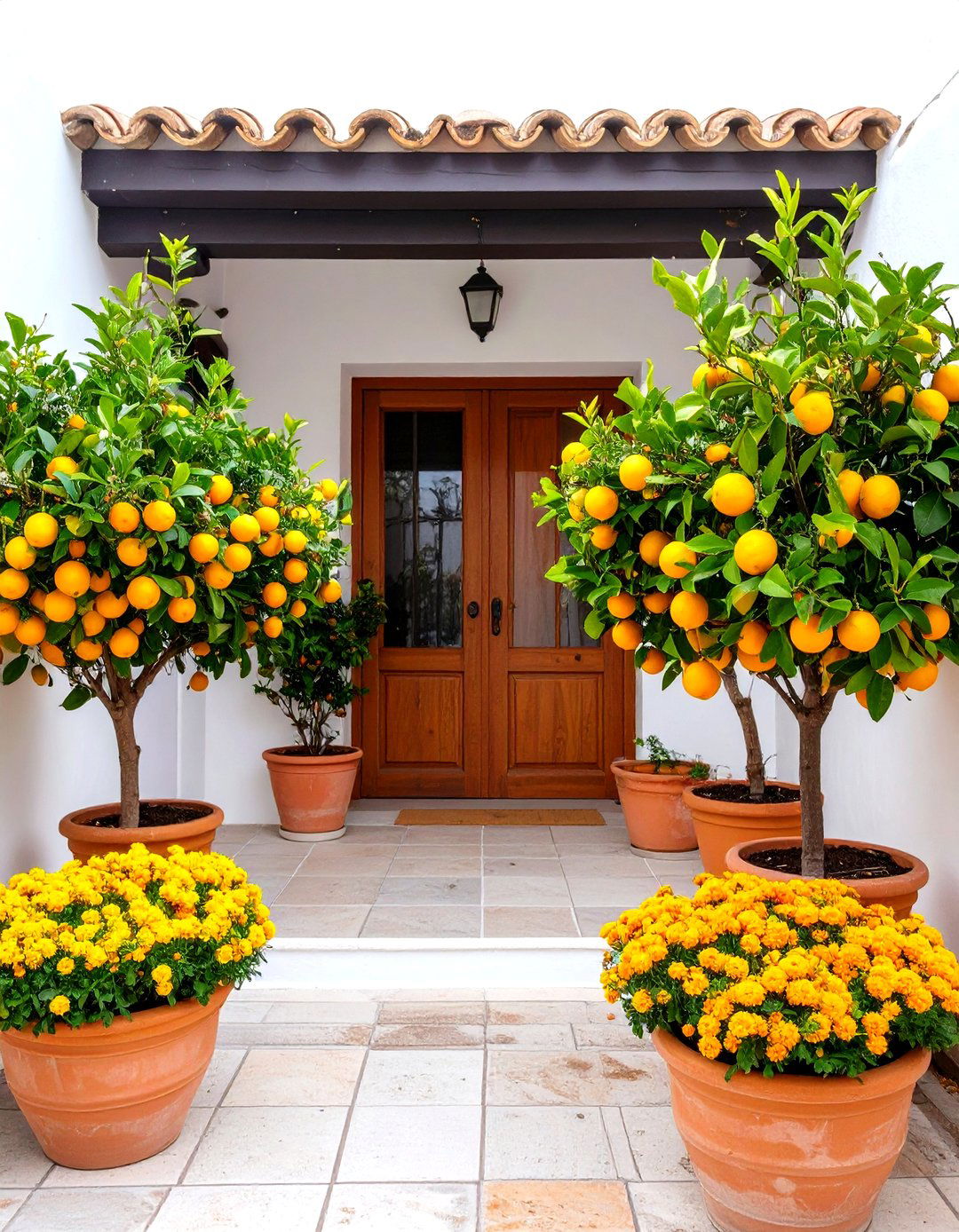
What better welcome than glossy leaves, scented blossoms, and glowing fruit from a potted lemon or kumquat beside the doorway? Choose dwarf rootstocks for small spaces and feed with a citrus-specific blend high in magnesium to prevent yellowing leaves. Shelter pots from winter frost by rolling them indoors or wrapping in horticultural fleece. Underplant with marigolds to deter aphids while splashing Mediterranean color. In bloom, citrus fragrance mingles with nearby jasmine for a truly Greek garden greeting.
8. Greek Column Planter Groupings
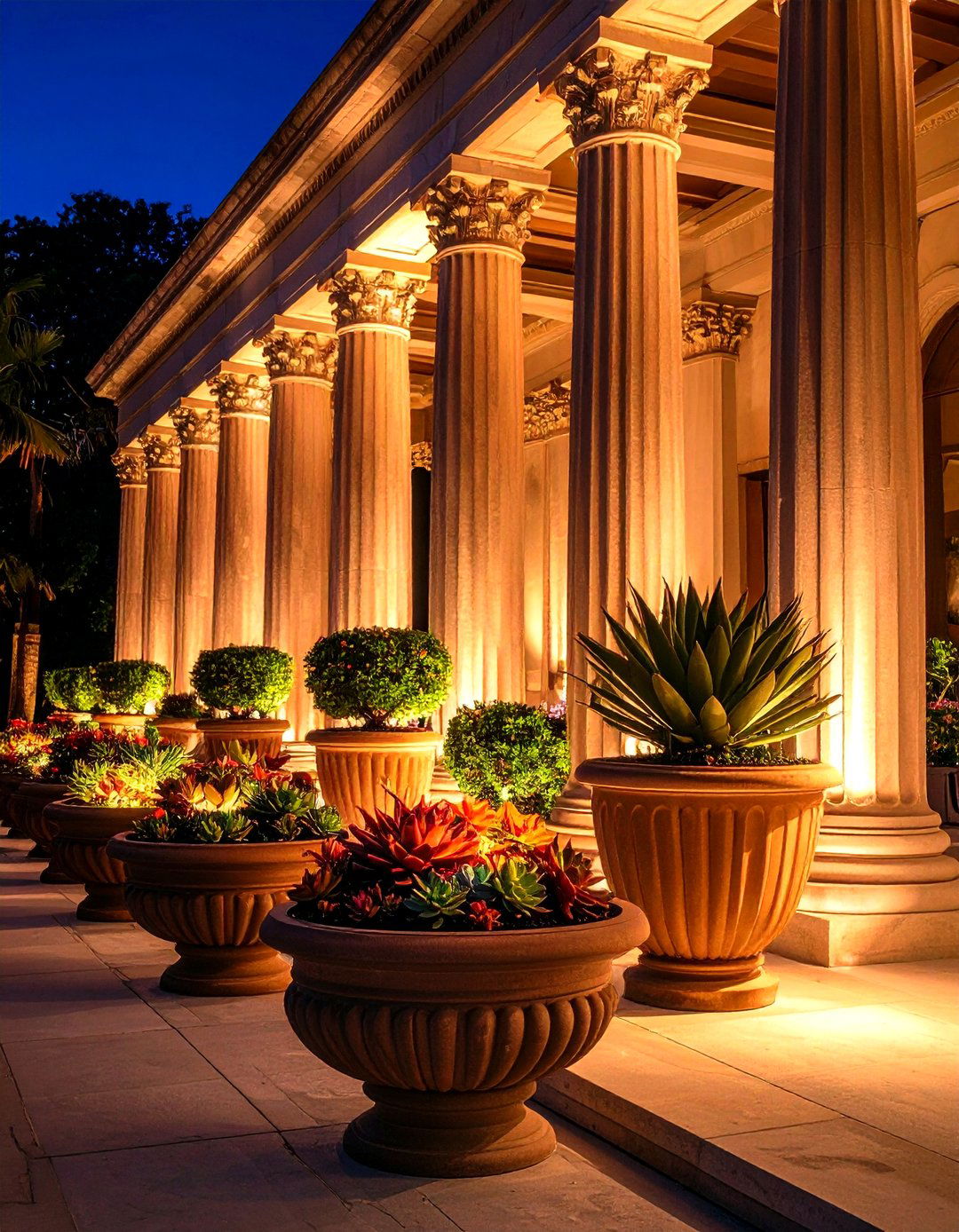
To introduce subtle grandeur, flank paths with fluted column fragments repurposed as pedestal planters. Their entasis taper naturally draws the eye upward, a classical optical trick perfected by ancient masons. Top each column with shallow bowls of succulents whose low water needs suit the porous concrete or stone. Arrange heights in odd-numbered clusters to avoid stiffness and spotlight at night for dramatic shadows that echo temple ruins.
9. Bougainvillea Burst
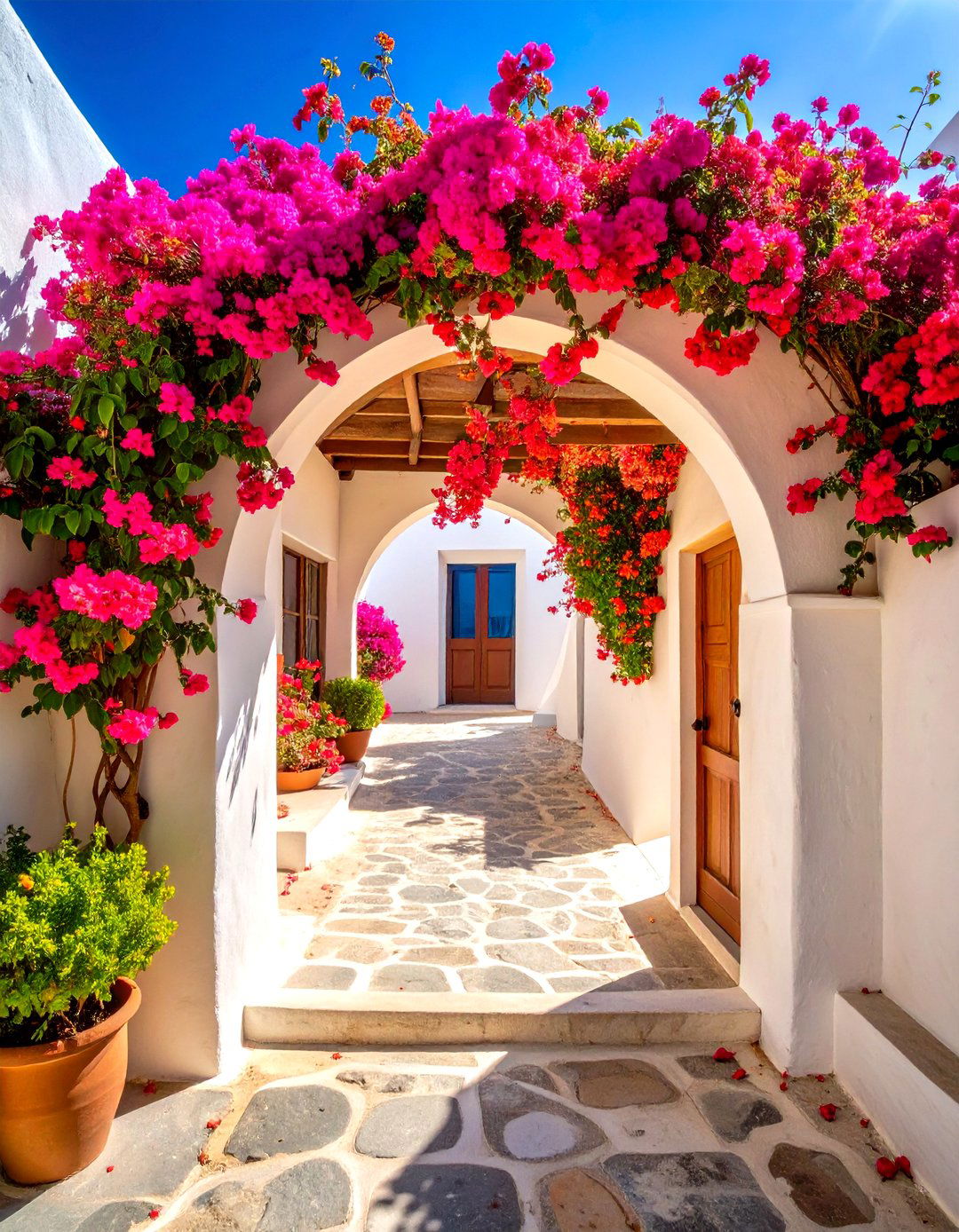
Certainly no Greek garden is complete without bougainvillea fanning across an archway, drenching the scene in magenta or coral splendor. Plant in the sunniest, driest wall you have; eight hours of direct light are the threshold for riotous bracts. Restrict water once established—deep, infrequent soakings sharpen color and curb legginess. Prune after the main flush to keep stems from smothering gutters, and feed lightly in early spring to encourage new flowering wood. Climbers can be kept smaller in pots by selecting Bambino cultivars.
10. Aegean-Inspired Water Feature
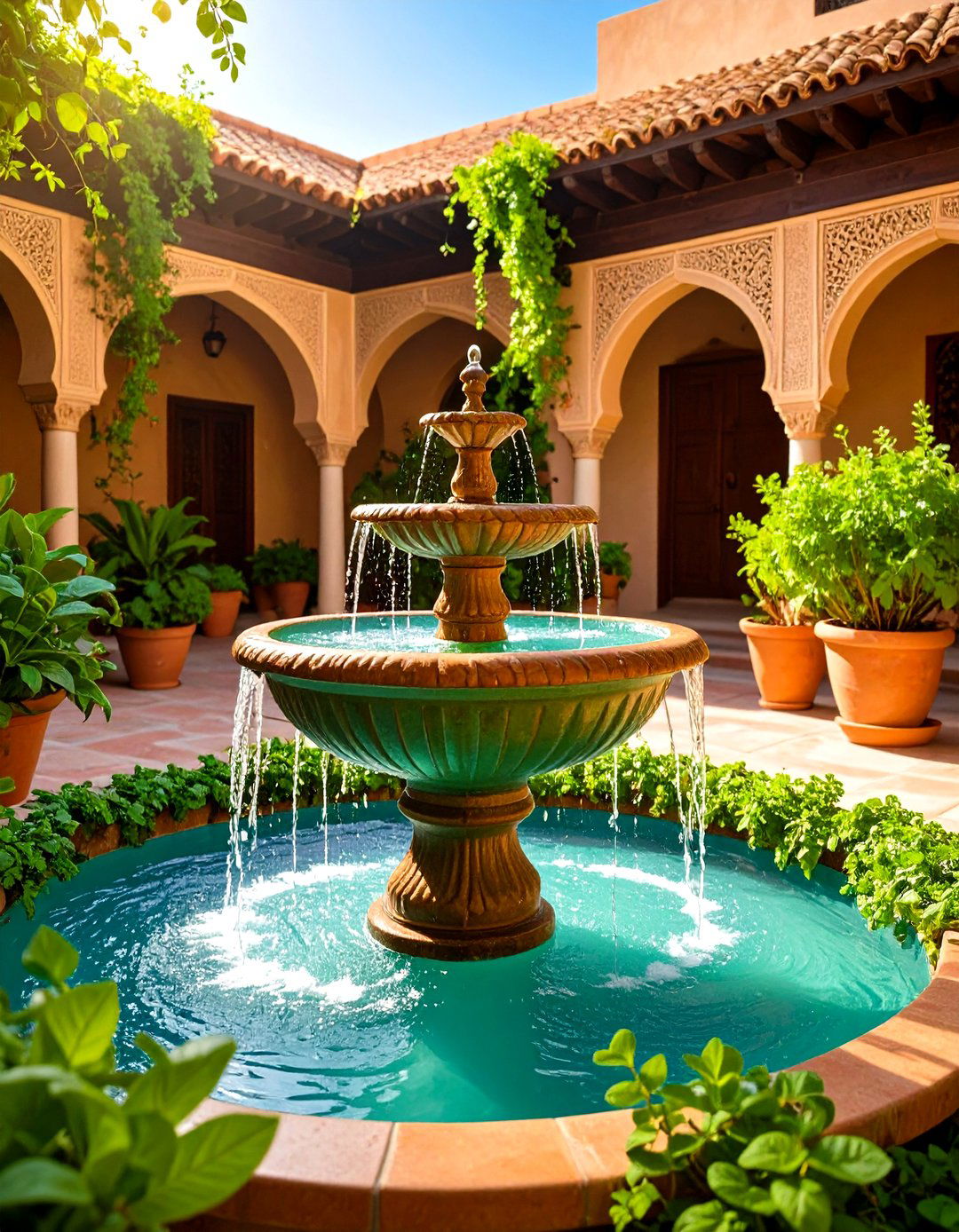
An urn-style fountain finished in “ancient rust” concrete brings the hush of Mediterranean courtyards without the splash of a pond. Re-circulating pumps minimize water use while providing gentle white noise that masks street sounds. Surround the basin with fragrant mint or pennyroyal; both thrive on occasional overspray and deter mosquitoes. For compact spaces, choose a 70 cm-wide model so you still have room to circulate around the feature.
11. Gravel Seating Plaza
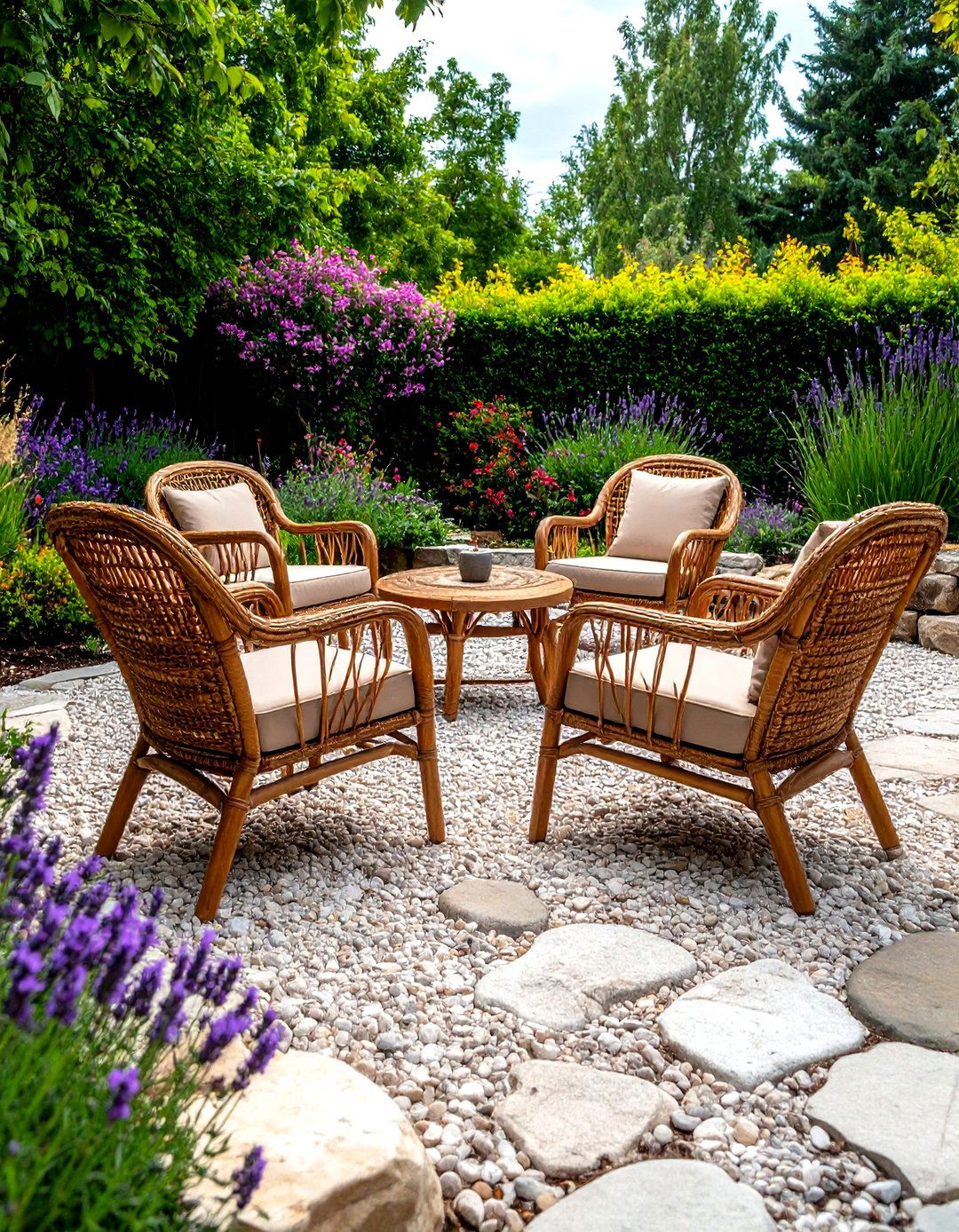
Unlike lawns that gulp irrigation, a limestone-chip terrace embodies the Greek preference for hard surfaces that store daytime heat. Level the area, lay a membrane, then spread 5 cm of pale gravel. Anchoring the plaza with a rough-hewn taverna table and woven chairs invites informal gatherings. Intersperse thyme or creeping oregano in small pockets between stones; their resilience tolerates foot traffic and releases perfume when crushed.
12. Greek Key Border Edging
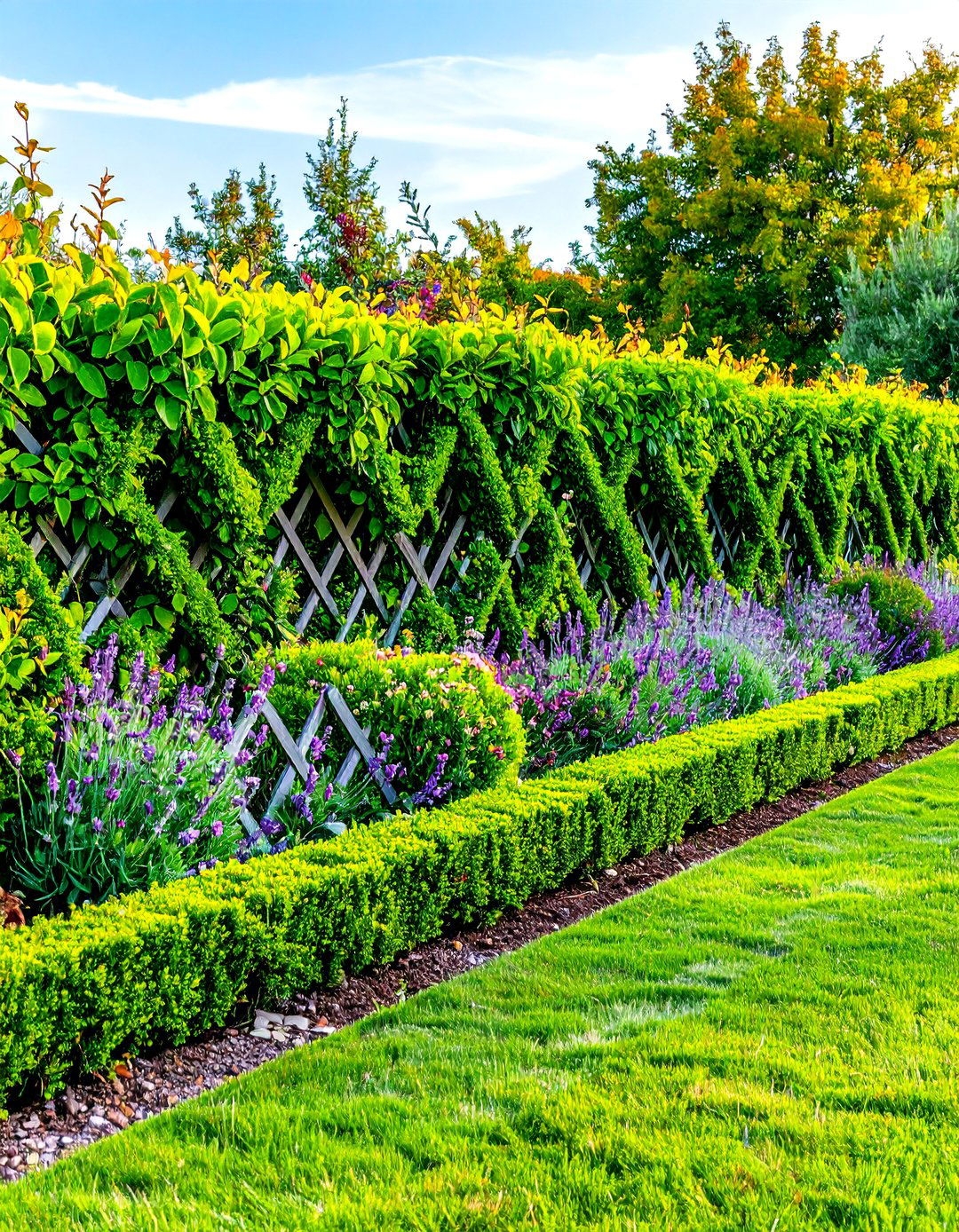
Take a cue from Rhodes’ historic pavements by clipping evergreen teucrium or myrtle into a low hedge that echoes the meander pattern. Set a string line first, then shear twice each summer for crisp angles. The distinctive geometry frames vegetable beds elegantly and hints at ancient symbolism—endless unity and flow.
13. Drought-Tolerant Plant Palette
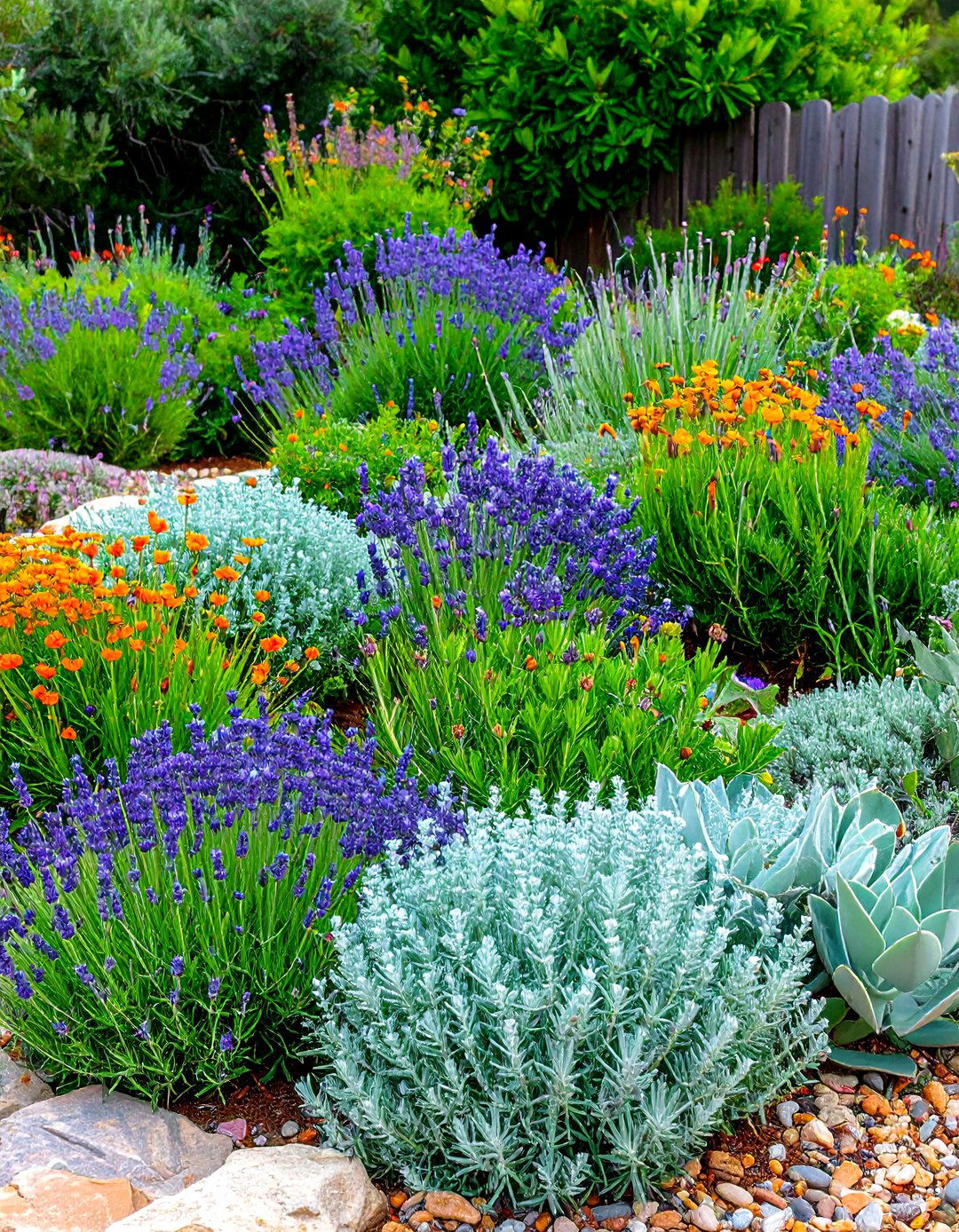
While rainfall dwindles, a Greek garden thrives on tough flora: lavender, cistus, rosemary, and rockrose evolved for stony soil and blazing sun. Plant in free-draining grit and resist the urge to enrich with compost; fertile soil shortens these plants’ lives. Group silvery foliage together so reflected light brightens shady corners and reduces overall irrigation zones. Once roots establish, a monthly soak is usually sufficient.
14. Sun-Soaked Patio with Bistro Set
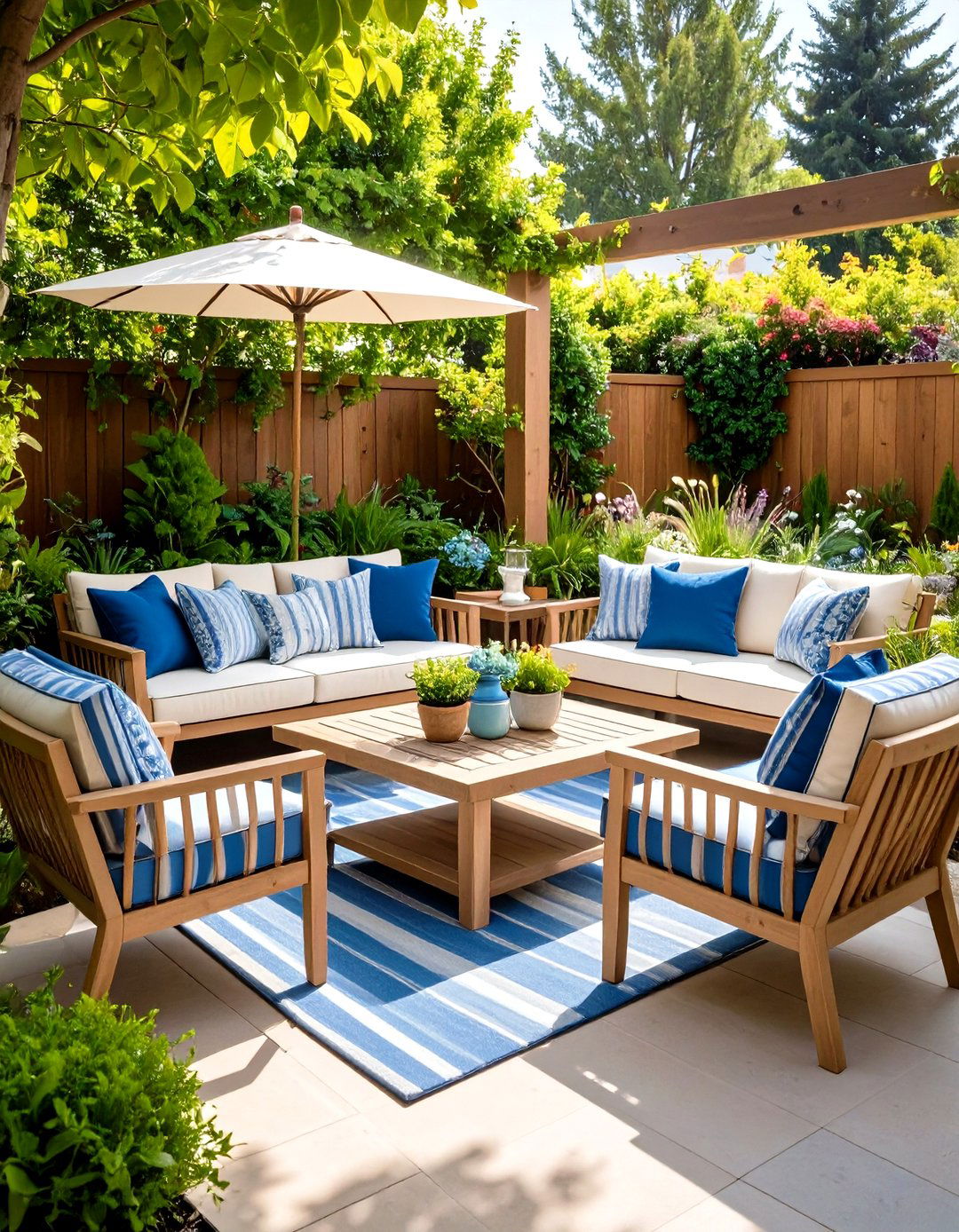
Shortly after midday, nothing feels more inviting than a small patio painted cream and trimmed in bright blue, mirroring Aegean tavern terraces. Pair a wrought-iron bistro set with striped cushions for casual meals, and use collapsible canvas awnings for adjustable shade. Pebble-filled trough planters slip behind chairs without hogging space and give place to scented pelargoniums that repel mosquitoes.
15. Sculptural Marble Statues

Unlike Italian formality, Greek gardens deploy statues sparingly—one or two marble torsos amid foliage hint at myth without clutter. Choose weather-resistant replicas and stand them against dark cypress or oleander so white stone gleams. Subtle up-lighting at the base dramatizes texture after dusk and aligns with the Hellenic tradition of honoring art outdoors.
16. Rustic Stone Bench Nook
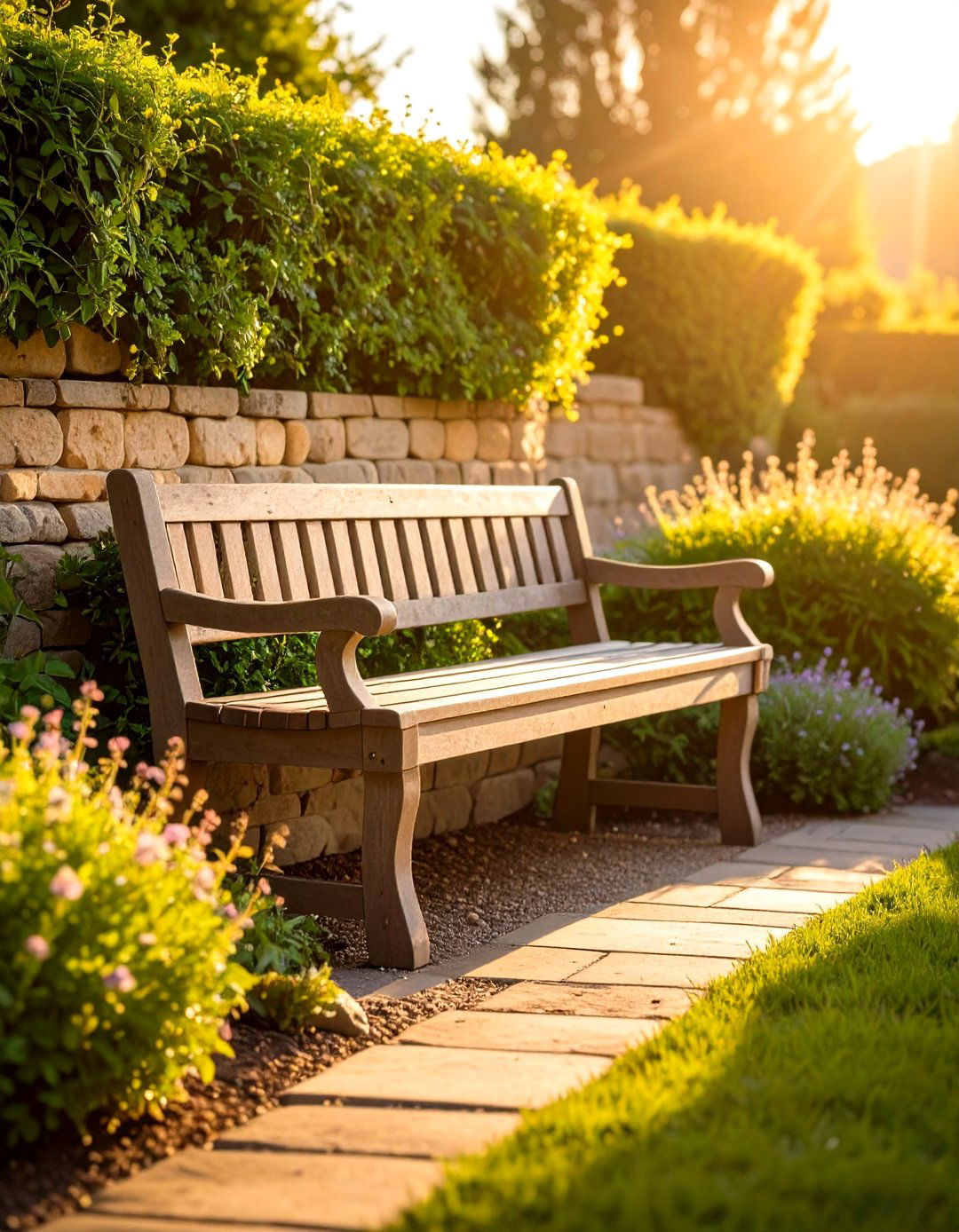
Looking for a contemplative corner? Dry-stack two tiers of local stone against a boundary wall to fashion a built-in bench that absorbs and releases warmth. Fill joints with creeping thyme to soften edges and perfume weary visitors as they sit. Position the bench to catch prevailing evening breezes and angle it toward the sunset because golden-hour light flatters limestone’s warm tones.
17. Grape Arbor for Shade & Fruit
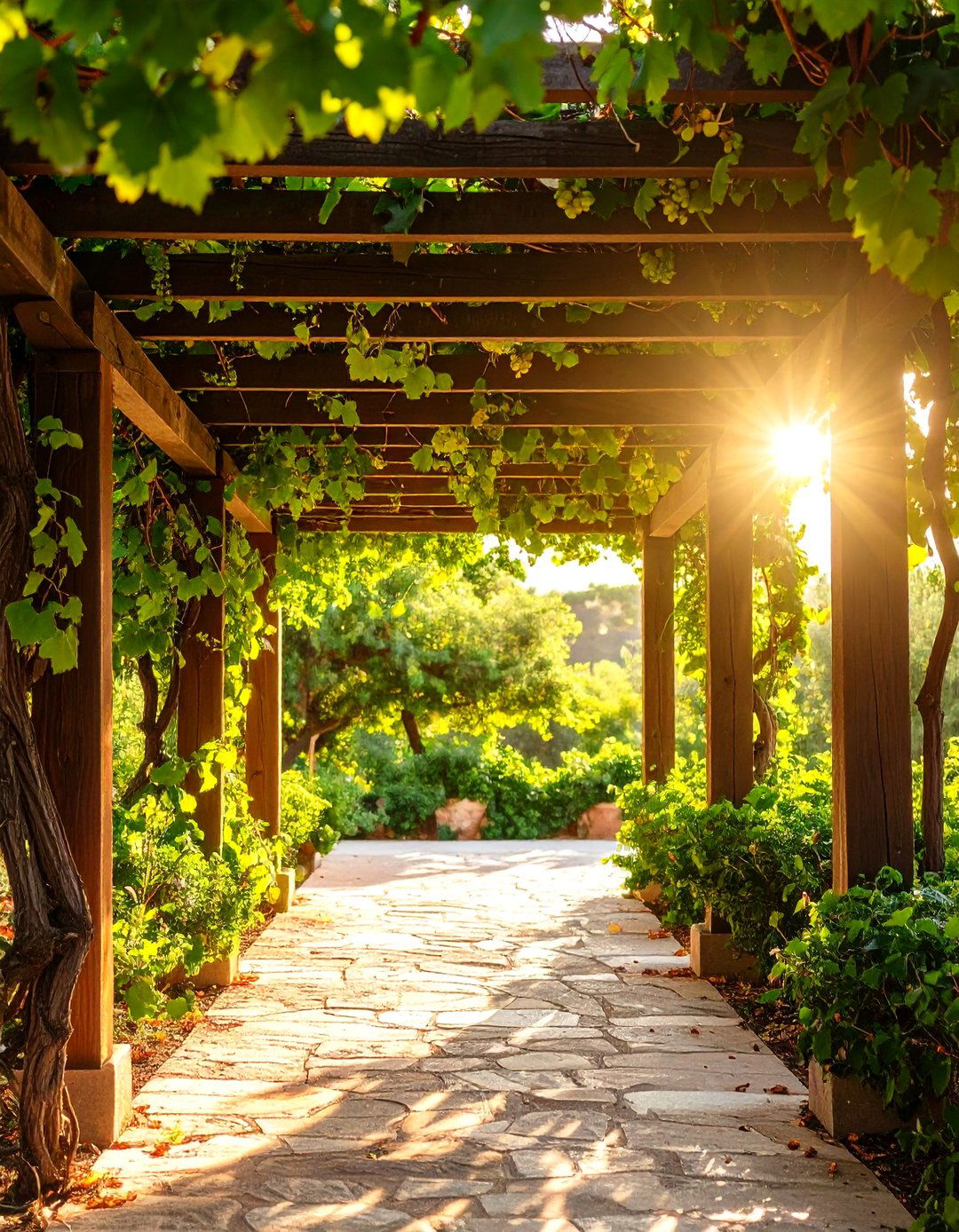
By late July, a mature vine spans overhead lattices, filtering sunlight while gifting clusters for breakfast. Grapes make superb “green roofs” provided you keep canes tied horizontally and prune spurs back to two buds in winter. Choose cultivars suited to your zone; Greek seedless “Sultanina” is heat-loving yet adaptable. Thin fruit once pea-sized to improve airflow and sweetness, and under-plant with basil, whose aroma deters wasps.
18. Sea-Glass Fire Bowl

At twilight, a low fire bowl filled with cobalt-blue glass beads evokes island bonfires beside the deep Aegean. The colored media refracts flame, creating jewel-like sparks without soot. Place the bowl on a gravel pad clear of overhanging branches and keep seating low for an intimate campfire vibe. During summer bans, swap flames for battery fairy lights tucked beneath the glass to maintain mood safely.
19. Rooftop Greek Garden Oasis

Before, a flat roof baked barren; after adding whitewashed planters, dwarf olives, and trailing succulents, it became a breezy Aegean escape. Use lightweight soil and drip irrigation to avoid structural overload. Cluster terracotta tubs along parapets for wind protection, then string festoons overhead to extend evening use. Cushioned pallets offer adaptable lounge seating that you can stow during storms. Even small balconies adopt Greek flair when you repeat white, blue, and clay tones consistently.
20. Night-Lit Greek Garden Ambiance
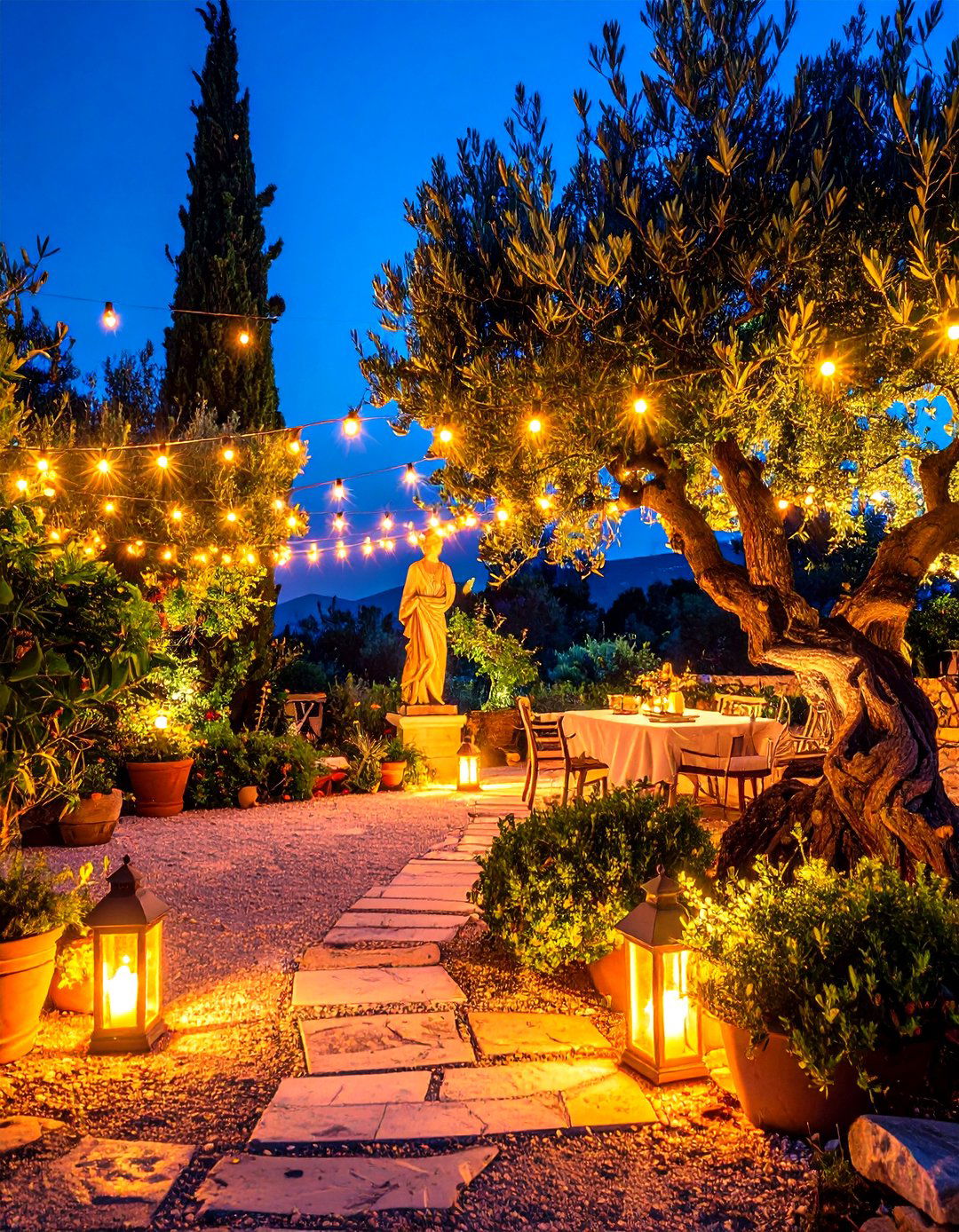
Finally, thoughtful lighting keeps the myth alive after sunset. Uplight an olive’s trunk for sculptural drama, backlight statues for mystery, and drape warm-white festoons across the pergola to mimic a canopy of stars. Solar lanterns tucked among herbs add gentle glow where powered cables won’t reach, ensuring your Greek garden remains enchanting yet energy-wise.
Conclusion:
Greek gardens blend time-honored resilience—olive trees, herbs, gravel, and whitewashed stone—with touches of luxury such as sea-glass flames and marble art, proving you can craft an idyllic, low-water haven on any scale. Silvery foliage glitters by day; lantern-lit pergolas and gurgling fountains soothe the night. Echo these twenty ideas, and your own plot will echo the ease, fragrance, and sun-soaked poise of the Aegean while asking for little more than sunlight, pruning shears, and the occasional glass of home-grown grape juice.


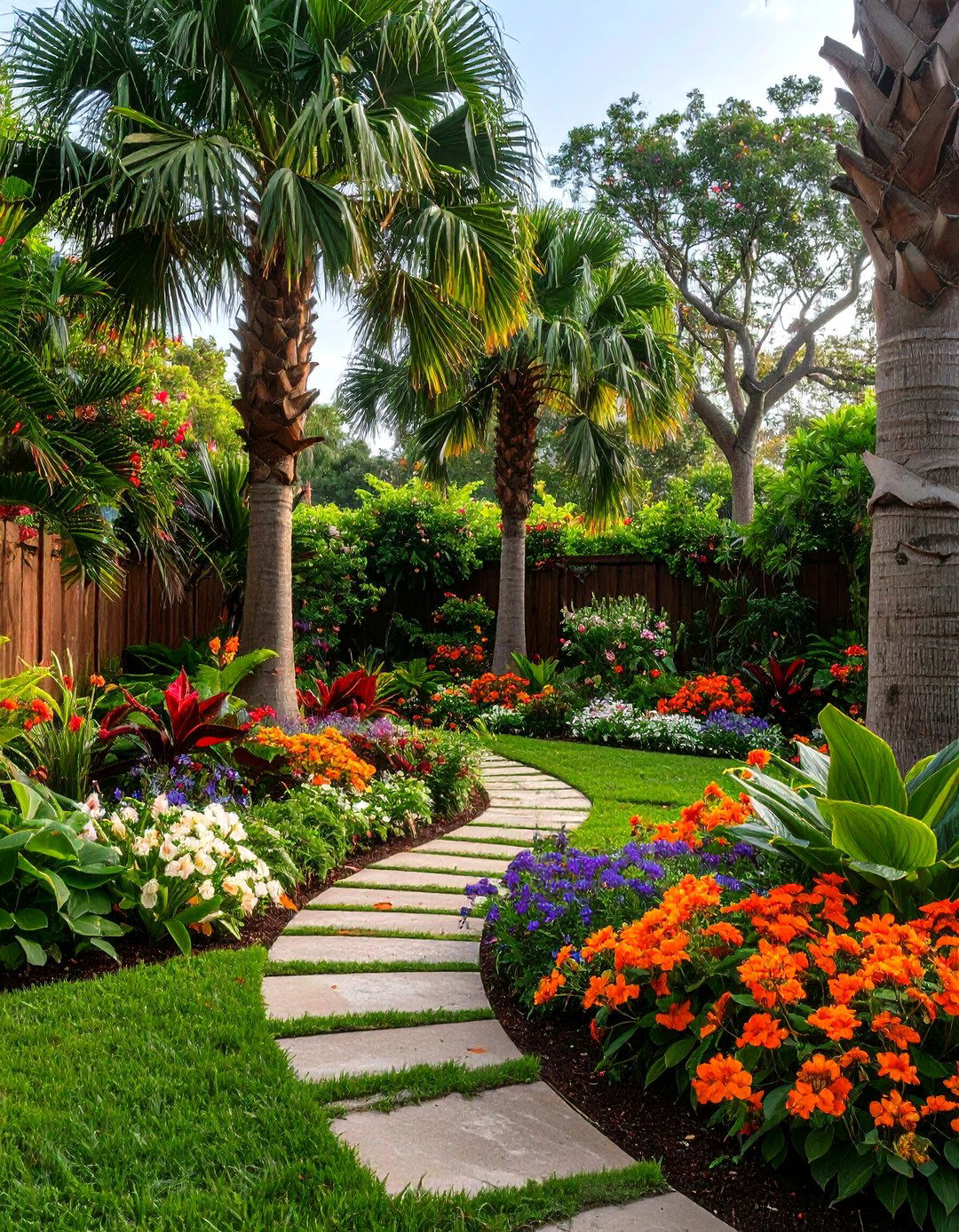


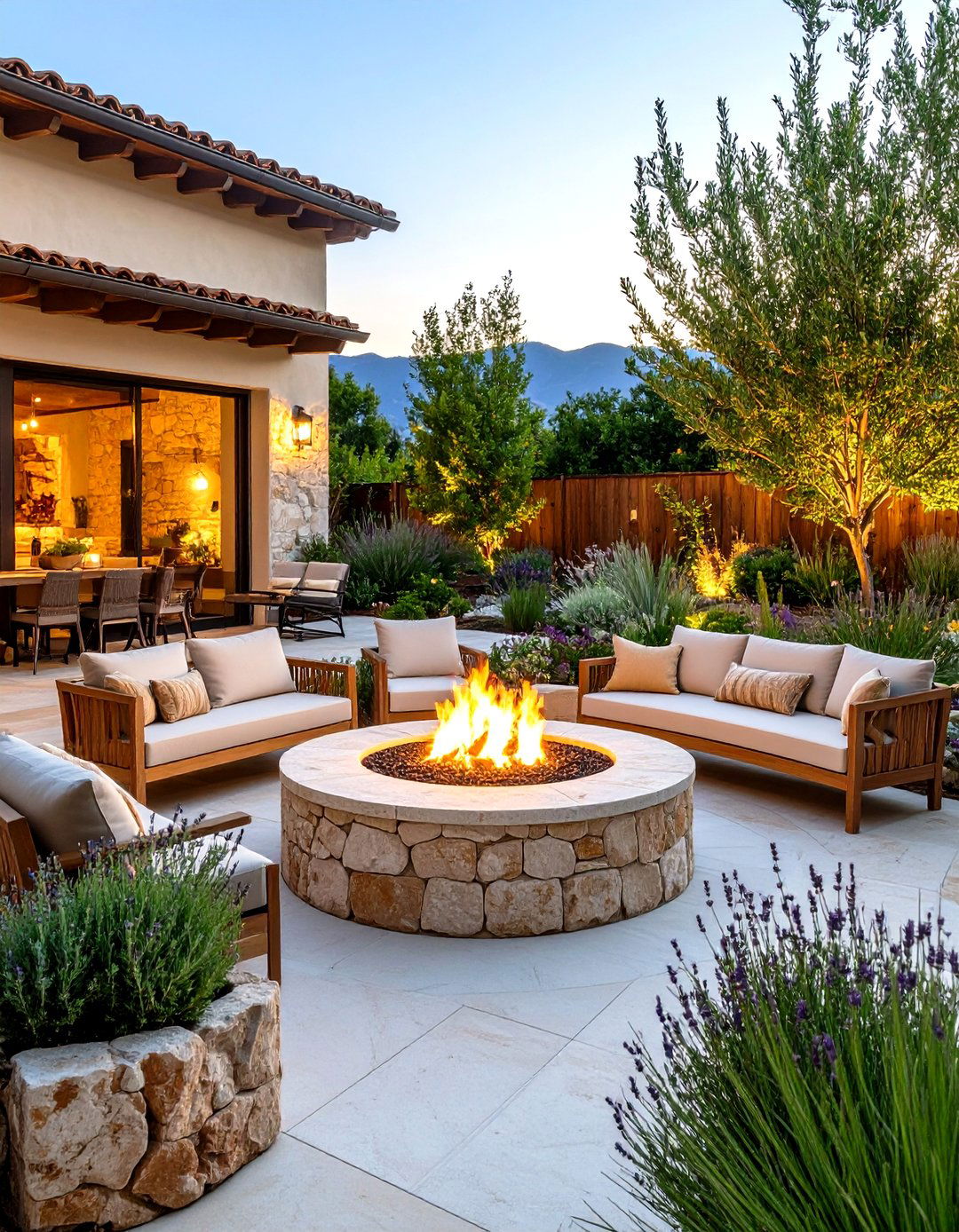


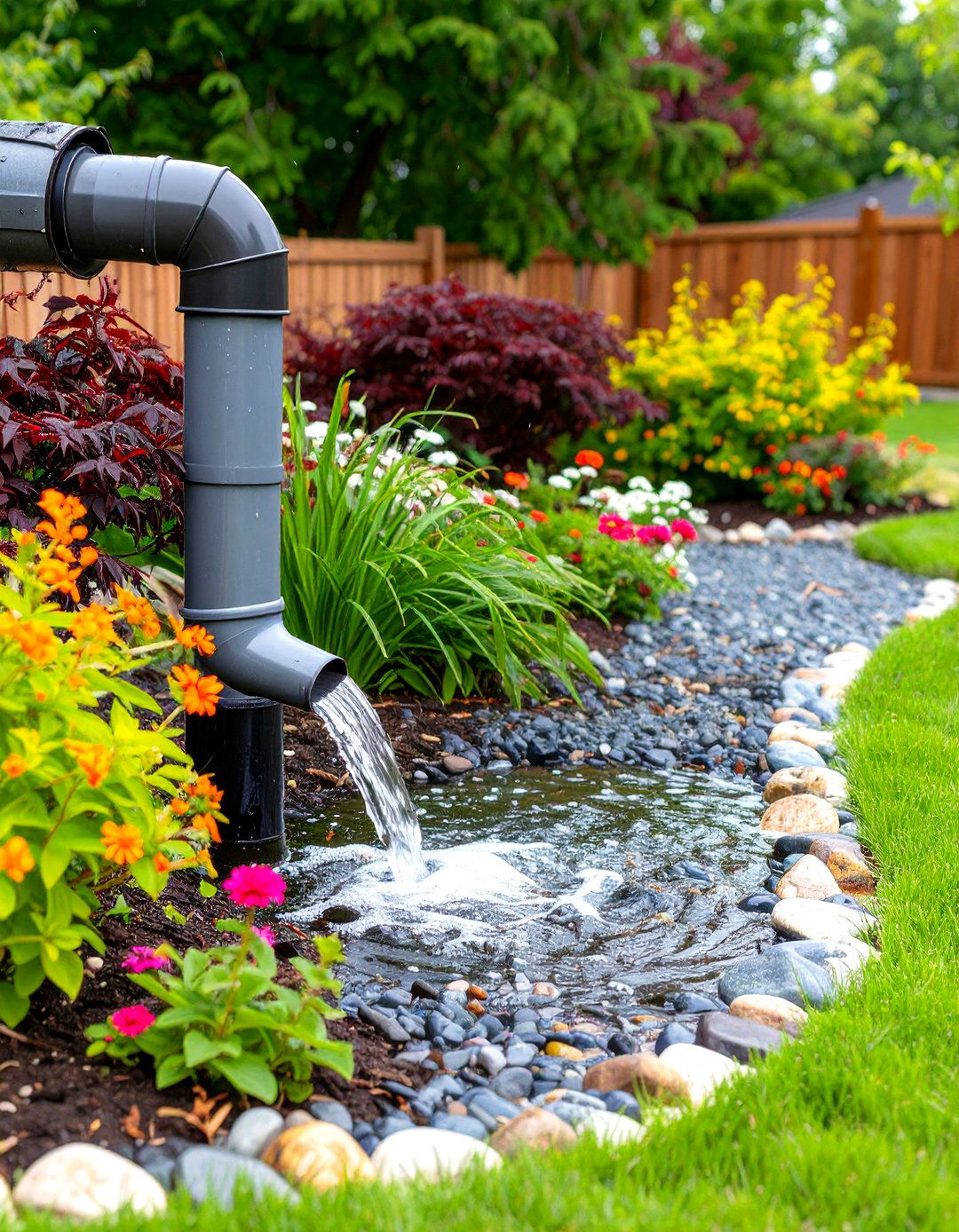


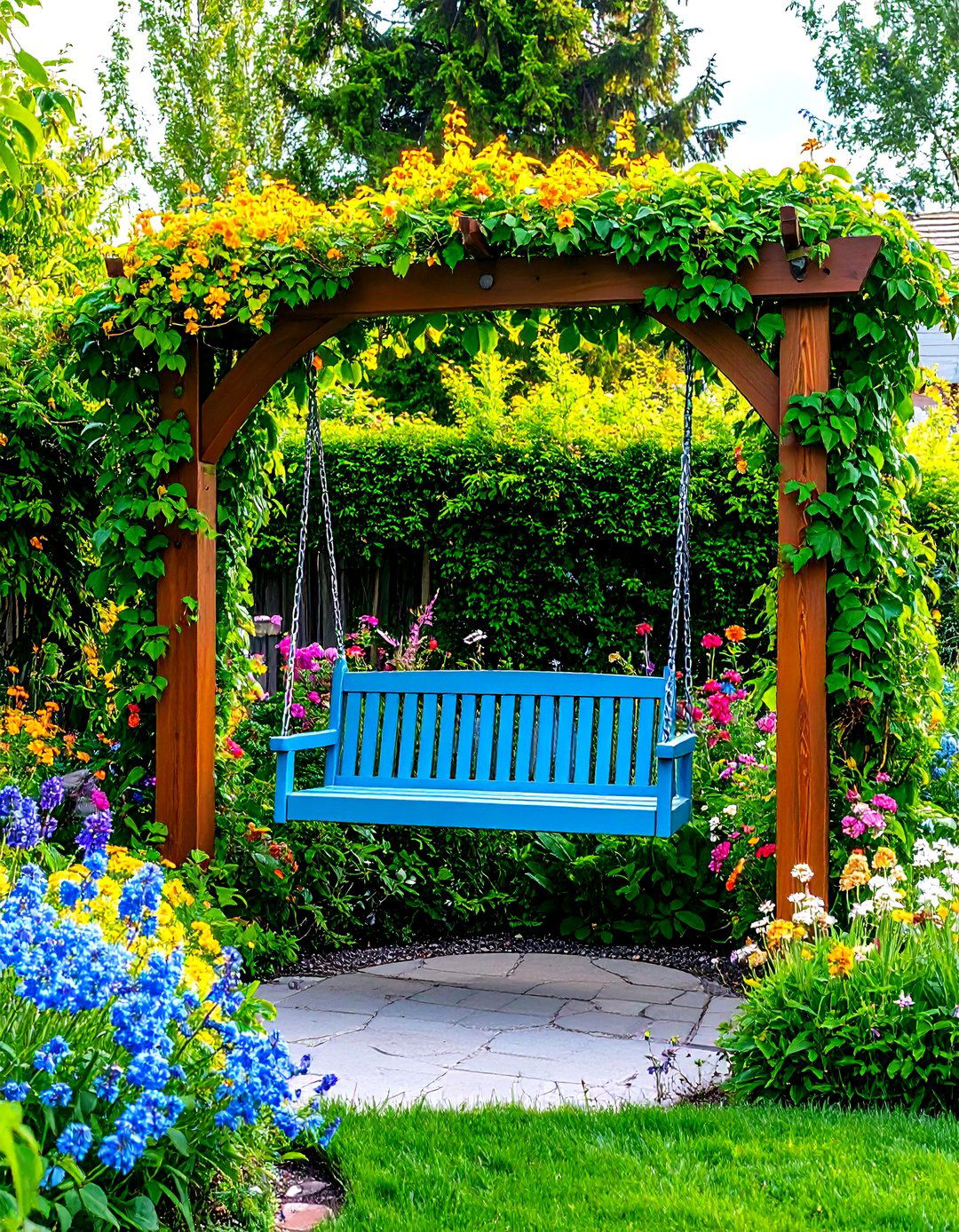
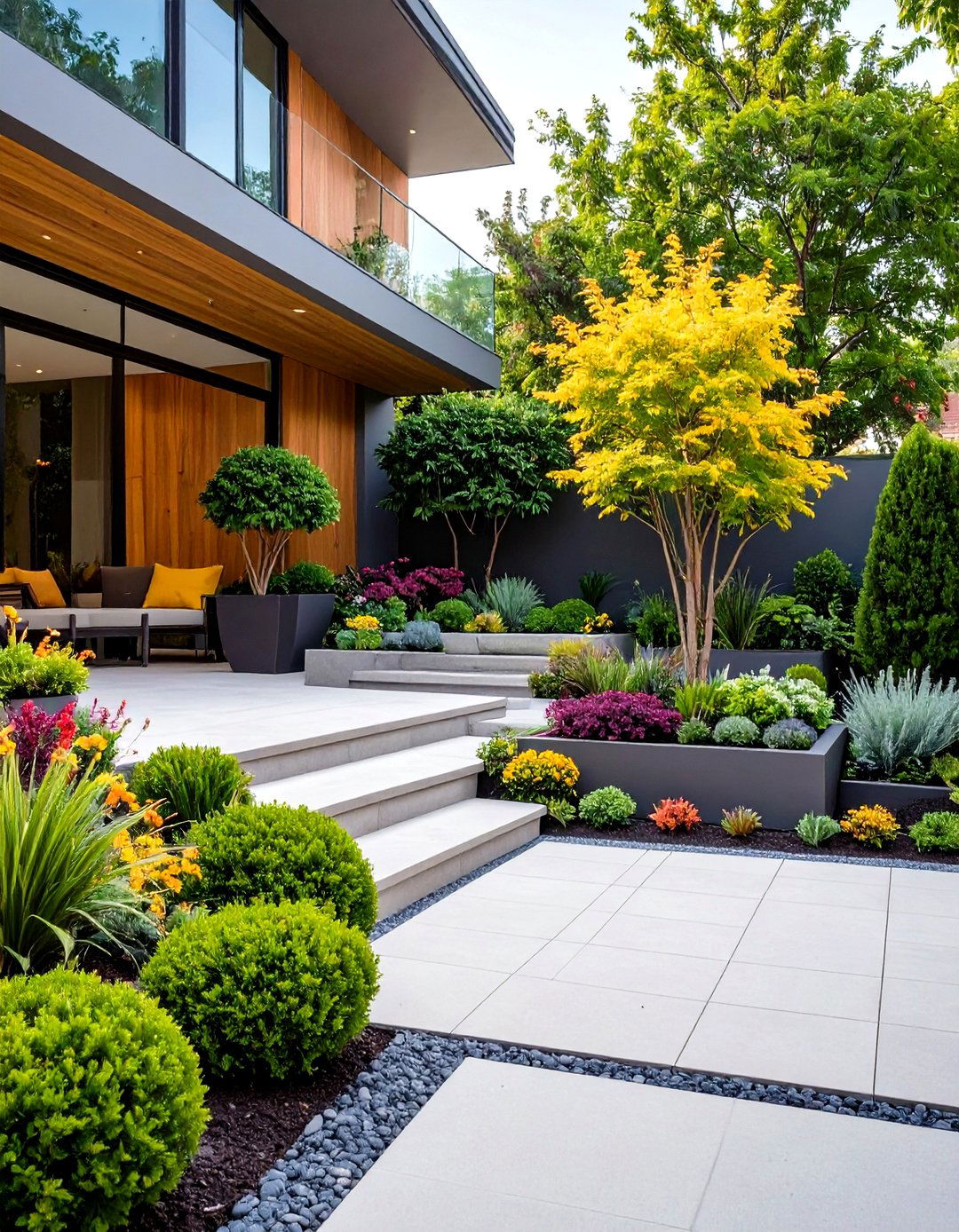


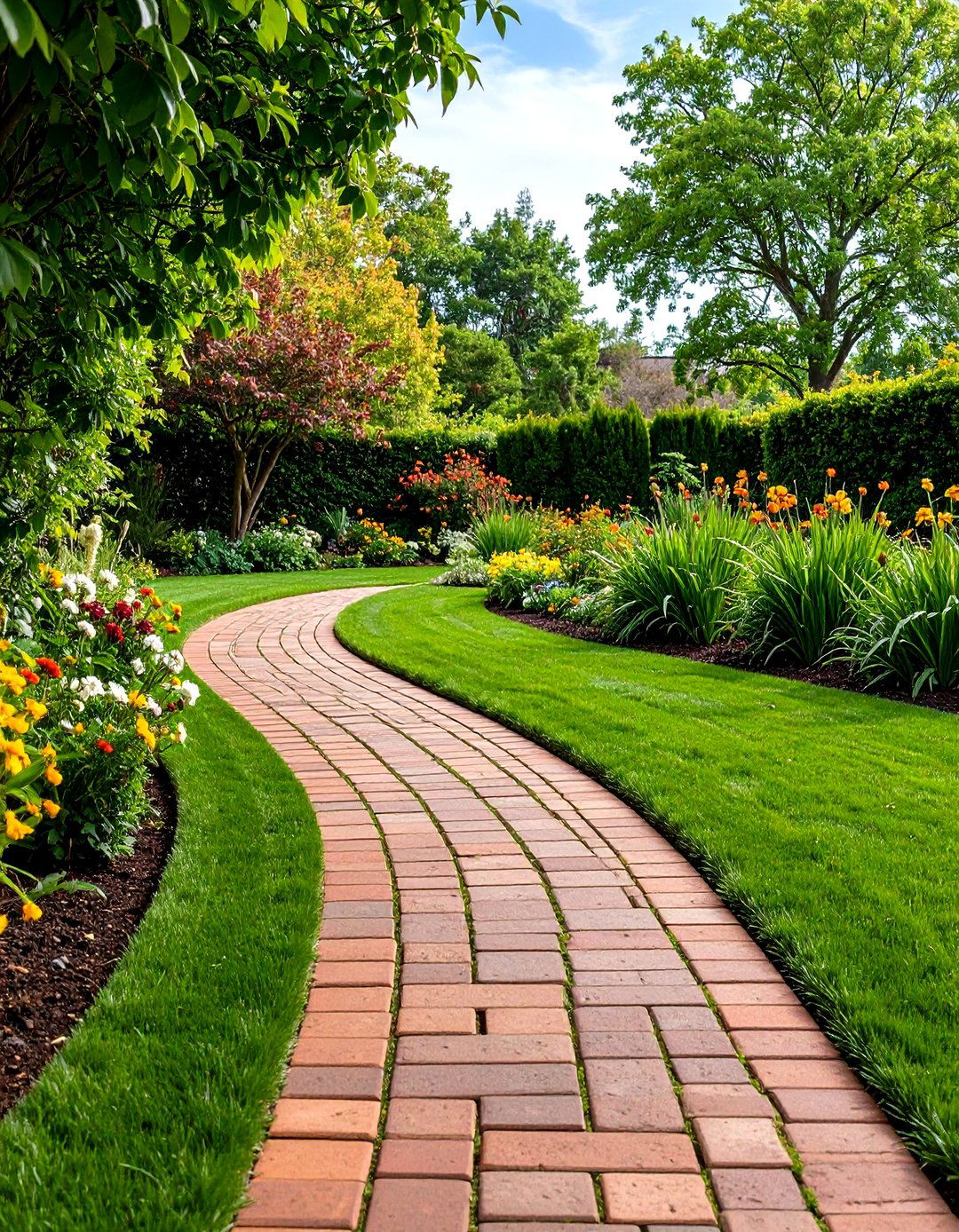
Leave a Reply